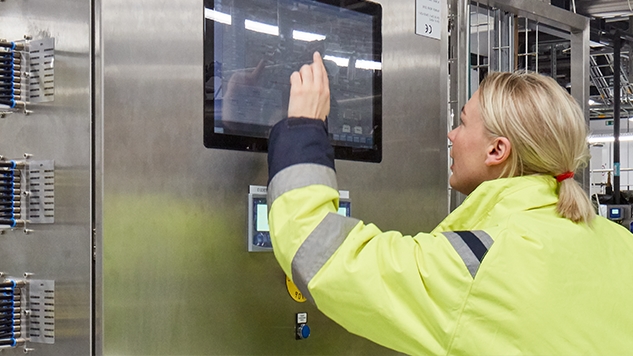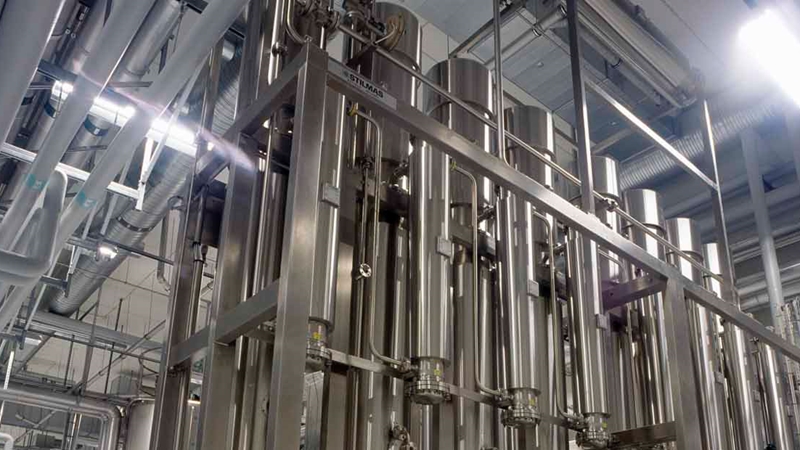“It drives co-creation and gives us a right-first-time design”. Read more about NNE's tailored approach to develop new software solutions that ensures maximum benefit for all.
NNE’s Manufacturing IT Solutions department works with consultancy, development, implementation and validation of manufacturing execution systems. It also creates custom application systems for production departments in the pharma and biotech industry.
Johanne Thinggaard, who gave the quote above, is a typical customer for the Manufacturing IT team. As IT administrator at one of Novo Nordisk’s many sites, her number one objective is to make sure production runs smoothly at all times and to drive continuous production optimizations to make production easier and more effective. One of her recent optimization initiatives was to update the technology of scanners used on-site to ensure a flexible and future-proof scanner solution. And that’s when NNE’s Manufacturing IT team came into the picture.
A truly agile pharma engineering approach
There are a lot of popular methodologies for modern software development: Kanban, Lean, SCRUM, Agile Engineering and Waterfall are the most popular. The Waterfall method is the most widely used and is also used – together with Kanban – in NNE’s large facility projects where the timelines usually span 2-5 years.
But in Manufacturing IT – where timelines are shorter and projects varied – this method didn’t quite work for software development projects. The problem was that none really helped to ensure effectiveness or mitigate risk. So, the team needed something tailored to NNE.
“We didn’t want to commit ourselves to one approach and have to follow the theory to the letter and be tied to a range of more or less rigid templates,” explains Specialist, Bo Erik Pedersen. “Instead we have taken elements from different methodologies and combined them in the way that it makes the most sense for us”.
We have taken elements from different methodologies and combined them in the way that it makes the most sense for us"
While strongly inspired by SCRUM, they use neither SCRUM, Waterfall, Kanban, lean nor agile engineering – instead NNE's team uses a truly agile and iterative method that is adapted to the crossover between software development and pharma manufacturing.
And it works. The department has been doing software development projects this way since 2011 with great results for both NNE and our customers.
Creating value instead of siloes
A key feature of our iterative approach is that we focus on one functionality of the software at a time (the SCRUM-inspired aspect). Everyone in the team works only with that function in short “iterations” of typically three weeks. During these three weeks, everyone works closely together to finish all aspects from A-Z. Once three weeks have passed, the element is 100% complete, internally tested and can be delivered to the customer. We then focus on the next functionality.
The super short deadlines mean high efficiency and constant momentum is paramount, with a clear endpoint in sight. “It’s easier to see if we are behind on the time schedule, so time management is much easier. This enables us to do much better reporting to the customer on a continuous basis, keeping them in the loop.” says Ulrik Farlov-Qvist, Senior IT Consultant.
We can do much better reporting to the customer on a continuous basis, keeping the customer in the loop of what’s happening."
Another important benefit is that solutions are integrated from the beginning because the team works together and coordinates efforts closely from day one. In contrast, the waterfall method can easily create siloes, as each project member is responsible for his/her part and works separately from other members. If the deadline is six months down the line, it's only then that you discover a mismatch between the e.g. coding and the test protocols – or worse: the delivered solution doesn't live up to the expectations of the customer. At the same time, the longer the deadline, the harder it is to plan your time and to measure how far you are from a finished delivery.
What’s in it for you? How we work with our customers
Unlike traditional methods, our approach involves you - the customer. Typically, we invite you for a meeting after each iteration, where we present the functionality to ensure it meets your requirements and expectations. Instead of “just” providing requirements lists at the beginning of the project and then waiting until NNE delivers the final product months down the line, this agile approach ensures you are integral to the journey.
Being involved in the development process like this, we have a much better chance at ending up with a solution that is satisfactory to all parties.”
For Johanne and her scanner update, this was a great approach. “Being involved in the development process like this, we have a much better chance at ending up with a solution that is satisfactory to all parties.” says Johanne Thinggaard. “The ultimate goal is to make the operators’ daily work easier, so it makes a lot of sense to include them in the process. She highlights that the co-creation approach allows the operators themselves to provide continuous input and adjustment suggestions, for example if they see an opportunity for extra features and functions that would optimize the final solution. “Another benefit of involving the operators in the development process is that they can create some hype and joyful expectations around the new solution among the other operators.” Finally, she points out that once they’re ready to start training the operators in the new scanner solution, it’s a huge advantage that their peers have been deeply involved in developing the job instructions.
Picture from customer meeting. The customer is invited for a half-day meeting where the NNE team goes through one functionality to make sure it meets the customer’s specifications and requirements.
Of course, not all of our customers have the time to spend half a day with us every three-four weeks – and we totally understand that. “It’s an offer - not mandatory. That’s part of the agility of our approach.”, says Bo Erik Pedersen, “But the customers that do embrace this way of working and take the time to participate in all the meetings, really appreciate it.”
A weekly whiteboard meeting. The NNE project team evaluates high-level task status of packages, "mood-meter”, issues and corrective actions
Overall, we find that our approach provides a completely different level of insight and visibility for our customers. Even if they don't participate in the meetings, they know exactly where we are in terms of the time schedule because we report with much shorter intervals. And because we’re always on top of the schedule and can catch errors early, the risk for significant delays or expensive corrections are much lower. So, this means predictability and security in terms of how the project – and their software solution – is progressing.
When discovering an error signifies success
JFunnily enough, sometimes the best experiences are found through an error. This is when an agile approach really proves its worth in terms of mitigating risk.
“Because we work this way, we discover errors much faster than with the traditional approach, where the error might not have been discovered until significantly later in the process, where it would be much more time-consuming and expensive to correct. So, fail fast – fail cheap.” explains Ulrik Farlov-Qvist. “Because we discover it faster, it only results in a minor slip in the timeframe which we can easily recover later so the overall timeframe it still met.”
Picture from a weekly ”Assembla” meeting. The NNE project team goes through all task tickets to make sure everyone is updated on what has been completed and what is still on the to-do-list
About Manufacturing IT solutions at NNE
We primarily handle MES-solutions on the level between the administrative systems (ERP) and process control systems (PCS, SCADA), which support:
- recipe handling,
- scheduling,
- production execution,
- quality control,
- material handling (often via barcodes),
- electronic batch documentation
- process optimization.
Furthermore, we also supply IT infrastructure, IT project management and manufacturing intelligence solutions for the pharma industry, such as IoT, Cloud, data optimization, and XR. Our solutions are typically based on the integration of standard system components from suppliers. In cases where the market does not meet client expectations, the department develops missing components.


